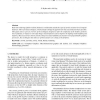Free Online Productivity Tools
i2Speak
i2Symbol
i2OCR
iTex2Img
iWeb2Print
iWeb2Shot
i2Type
iPdf2Split
iPdf2Merge
i2Bopomofo
i2Arabic
i2Style
i2Image
i2PDF
iLatex2Rtf
Sci2ools
CGF
2005
2005
Survey of Real-Time Rendering Techniques for Crowds
Real-time rendering of photo-realistic humans is considerably outside the scope of current consumer-level computer hardware. There are many techniques, which attempt to bridge the gap between what is desired and what is possible. This paper aims to give an overview of the techniques designed to alter the complexity of the model's geometry (level of detail), or replace it with a flat image (visual impostor) and to improve the lighting model (lighting and shadows). Recent years have shown a boom in the power and availability of consumer-level programmable graphics processors, thus techniques that make use of these features are coming to the forefront.
| Added | 15 Dec 2010 |
| Updated | 15 Dec 2010 |
| Type | Journal |
| Year | 2005 |
| Where | CGF |
| Authors | G. Ryder, A. M. Day |
Comments (0)

